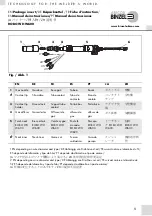
21
Parts & Service: 020 8988 7400 / E-mail: [email protected] or [email protected]
OPERATION
1. With the welding current set and the wire trimmed, set the wire feed
control to 6.
2. Plug the machine into the mains supply and switch on.
3. Cover your face with a welding mask or welding helmet.
• This is essential.
4. Lower the torch to the workpiece with one hand and approach the work
with the torch tip at an angle of about 35
o
and pull the torch trigger fully.
• As the wire touches the workpiece an arc will be struck.
5. In order to produce a satisfactory weld, the controls may be fine tuned as
required. This will come with practice.
NOTE:
MIG welding is an acquired skill. It is strongly advised that, if you
are not fully familiar with this type of welding, you practice on a
piece of material with the same characteristics as your workpiece
until you are satisfied with the result, and you have fine tuned your
welder to produce a satisfactory weld.
NOTE:
One of the problems experienced with novice welders is the
welding wire sticking to the contact tip. This is as a result of the
wire feed speed being too slow. It is always better therefore to
start with too high a speed and back off slightly to avoid the
possibility of the wire welding itself to the tip. This is the reason
position 6 is recommended for start up.
NOTE:
The Wire Feed control is for fine tuning the wire speed. The speed
of wire delivery will increase automatically as the current is
increased. Therefore, once the ideal speed is achieved by fine
tuning, it should not be necessary to adjust this control when the
welding current is changed.
NOTE:
Listen to the sound made. An irregular crackling sound denotes
too high a wire speed. Decrease the speed until a regular, strong
buzzing sound is heard.
CAUTION: THE DUTY CYCLE MUST BE ADHERED IN ORDER TO PREVENT
THE THERMAL OVERLOAD PROTECTION FROM ACTIVATING
Summary of Contents for 6014505
Page 32: ......












































